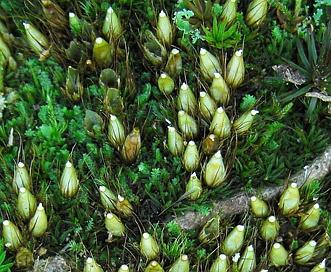
Diphyscium-foliosum-AH-226-.jpg from: https://sites.cortland.edu/bryophytes/field-guide/mosses/acrocarp/diphyscium-foliosum/
Discovering the Fascinating World of Diphyscium fendleri Moss
Diphyscium fendleri Müll.Hal., commonly known as Diphyscium moss, is a captivating species of moss belonging to the Diphysciaceae family. This tiny but mighty plant plays a significant role in its ecosystem and boasts unique adaptations that allow it to thrive in various habitats across the globe. In this blog post, we’ll dive into the fascinating world of Diphyscium fendleri and explore its morphology, distribution, ecological roles, and more.
Background on Bryophytes and Mosses
Before we delve into the specifics of Diphyscium fendleri, let’s briefly touch on the broader context of bryophytes and mosses. Bryophytes, which include mosses, liverworts, and hornworts, are non-vascular plants that lack true roots, stems, and leaves. Despite their small size, bryophytes play crucial roles in ecosystems, such as regulating moisture, preventing soil erosion, and providing habitat for microorganisms.
Mosses, scientifically classified under the division Bryophyta and class Bryopsida, are the most diverse and abundant group of bryophytes. They are known for their ability to colonize a wide range of substrates and environments, from moist forests to rocky outcrops and even urban areas.

827623.jpg from: https://www.bio-forum.pl/messages/3280/827614.html

217222.jpg from: https://inpn.mnhn.fr/espece/cd_nom/3888
Morphology and Identification of Diphyscium fendleri
Diphyscium fendleri is a small, acrocarpous moss, meaning it produces sporophytes at the tips of its stems. The plant forms dense, cushion-like tufts, typically measuring 1-3 cm in height. The leaves are lanceolate to ovate-lanceolate, with a pointed apex and a costa (midrib) that extends to the leaf tip. The leaf margins are entire or slightly toothed near the apex.
One of the most distinctive features of Diphyscium fendleri is its unique sporophyte morphology. The sporophyte consists of a short seta (stalk) and an asymmetrical, oblique capsule. The capsule is characterized by its swollen, ventricose base and a narrow, elongated neck. This unusual shape gives the sporophyte a somewhat flask-like appearance.
Global Distribution and Habitat
Diphyscium fendleri has a wide distribution, occurring in various regions across the globe. It can be found in North America, Central America, South America, Europe, Asia, and Africa. The moss inhabits a range of habitats, including moist forests, shaded rock outcrops, and soil banks along streams and rivers.
In terms of substrate preferences, Diphyscium fendleri is known to grow on soil, humus, and rock surfaces. It often forms extensive mats or patches in suitable microhabitats, where it benefits from consistent moisture and shade.
Ecological Roles and Adaptations
Like other mosses, Diphyscium fendleri plays important ecological roles in its habitats. The dense tufts formed by this moss help to stabilize soil, prevent erosion, and retain moisture. The plant’s ability to absorb and hold water also contributes to the regulation of local hydrological cycles.
Diphyscium fendleri exhibits several adaptations that enable it to thrive in its environment. The moss has a high tolerance for shade, allowing it to grow in low-light conditions beneath forest canopies or in crevices. Additionally, the plant’s small size and compact growth form help to minimize water loss and protect it from desiccation during dry periods.

jim__stasz_19603059732_e96964bd30_c.jpg from: https://www.marylandbiodiversity.com/view/10825

Diphyscium_foliosum.jpg from: https://www.britishbryologicalsociety.org.uk/learning/species-finder/diphyscium-foliosum/
| Characteristic | Description |
|---|---|
| Family | Diphysciaceae |
| Genus | Diphyscium |
| Species | Diphyscium fendleri Müll.Hal. |
Plant Height
 medium.jpg from: https://www.inaturalist.org/taxa/555763-Diphyscium-fulvifolium |
1-3 cm |
| Leaf Shape | Lanceolate to ovate-lanceolate |
| Leaf Apex | Pointed |
| Leaf Margins | Entire or slightly toothed near apex |
| Sporophyte | Asymmetrical, oblique capsule with swollen base and narrow neck |
| Habitat | Moist forests, shaded rock outcrops, soil banks along streams and rivers |
| Substrate | Soil, humus, rock surfaces |
| Distribution | North America, Central America, South America, Europe, Asia, Africa |
Conclusion
Diphyscium fendleri may be small in stature, but it is a fascinating and ecologically important moss species. Its unique morphology, wide distribution, and adaptations make it a captivating subject for bryologists and nature enthusiasts alike. As we continue to study and appreciate the diversity of bryophytes, we gain a deeper understanding of the complex web of life that exists in even the smallest corners of our planet.
So the next time you find yourself in a moist, shaded habitat, take a closer look—you might just spot a tiny tuft of Diphyscium fendleri, quietly playing its role in the grand scheme of nature. What other secrets might these diminutive plants hold, and how can we continue to learn from them?